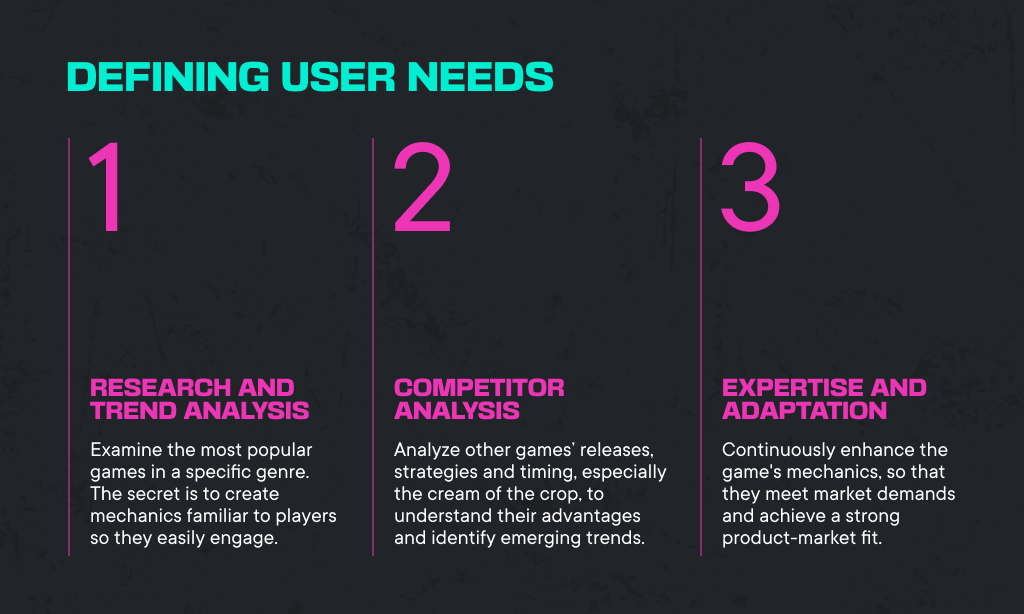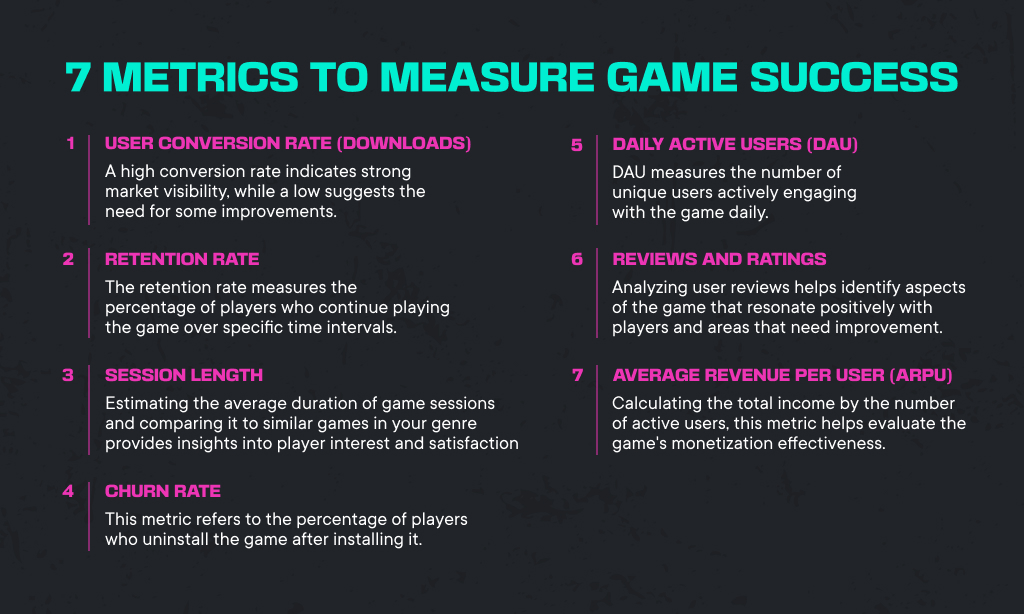My name is Anastasiia Tsybezova, and I am a Game Development Manager at Innovecs Games.
I’d like to share some key steps I follow when managing the development of a new game. In this article, I will showcase the importance of product thinking in the Gaming industry and guide you through the essential stages, from determining user needs to managing the game’s success.
The Role of Product Thinking
The interplay between product thinking and game design is paramount. It’s a journey that starts with deep market analysis and audience identification. By analyzing competitors and understanding market demand, I gain valuable insights into the preferences of our target audience. Considering factors such as age groups, gender, and the functionality of top-market products, I strive to direct our products in a way that fully aligns with users’ interests and needs. This approach creates a strong connection with players and enhances their overall experience.
An important aspect of defining a product market fit is to conduct ongoing research, collect feedback and perform analysis. It is more cost-effective to adjust the game’s idea or direction at an early stage if it does not meet the desired product-market fit rather than investing significant resources in its creation only to realize later that changes are needed. This proactive approach enables us to make informed decisions and bring the game closer to meeting players’ expectations while optimizing resource allocation.
The more confirmations of the hypothesis about the product market fit for the future product, the higher the chances for the game to gather its target audience.
I continuously test our games, gather feedback, and analyze players’, clients’ and development team responses.
The fundamental aspect that I consistently consider is the product-market fit. As part of my responsibilities, I conduct thorough research on competitors, analyze the app market, and evaluate the popularity of similar games. To gain valuable insights into market trends, competitive analysis, and user engagement metrics, I utilize tools such as Gamerefinery or Sensor Tower.
Defining User Needs
Determining user needs is vital in game development. We ensure the game’s mechanics align with market demands, resulting in a compelling and successful gaming experience.

- Research and Trend Analysis: We dive into the gaming world, examining the most popular games in a specific genre. By studying the core gameplay and mechanics, we gain valuable insights into what resonates with players. The secret lies in creating mechanics with which players are already familiar so they effortlessly engage.
- Competitor Analysis: We carefully analyze other games, especially the cream of the crop, to understand their advantages and identify emerging trends. We examine their release strategies, timing, and main metrics. Having this knowledge, we prepare a comprehensive development plan for the game’s initial launch, which we present to the client.
- Expertise and Adaptation: By leveraging our extensive expertise and industry knowledge, we incorporate the unique game, setting it apart from competitors. We continuously enhance the game’s mechanics, ensuring they meet market demands and achieve a solid product-market fit. If our expertise leads us to suggest alternative ideas to the client’s initial vision, we rely on trends and analysis of best practices to validate our recommendations.
Identifying Users’ Pain Points
When it comes to analysis, there are two key approaches: studying competitor games and thoroughly examining your own game.
As for the competitor’s game, you can read players’ reviews and engage with gaming communities on platforms like Discord or Facebook. Note what players like and dislike, discover what engages players the most, and identify the best features in those games. While this won’t guarantee specific findings, staying active in similar games and monitoring updates allows you to spot trends and gain insight into future directions.
Continuing testing, I analyze the flow and requirements during the entire development cycle. I evaluate whether the transitions between game stages are smooth and players may encounter any challenges or confusion. I share and align my observations with the team first and then with a client.
Another method is Customer development: to allow friends, family, or teammates who match your target audience to playtest the game. Observe their impressions and document feedback, noting what they enjoy, find difficult, or where they get stuck. Compare this feedback with your assumptions to confirm or adjust them.
All in all, here’s what really matters:
- Internal analysis and alignment: Define the team’s vision and client requirements.
- Market analysis.
- Initial game version and feedback gathering: Develop an early version of the game and seek feedback from potential players to evaluate its usability and engagement.
- Pre-release iteration: Incorporate feedback, iterate on the game, and undertake carefully testing for a polished experience.
- Release and in-game analytics: Monitor player interactions and progress within the game using in-game analytics.
- Feedback and perception evaluation: Collect player feedback, including reviews, to assess the game’s perception and identify areas for improvement.
Aligning Business Goals with User Needs
An essential aspect of our strategy is optimizing advertising and maintaining customer benefit. We employ several approaches to maximize user interaction while aligning ad impressions with our business objectives:
- Ads Placement: We diligently analyze experiences from our other games to determine the most visible ad placements. Additionally, we conduct post-launch analytics to identify areas where ads receive the most attention. If we discover that certain ad placements are causing discomfort to players and resulting in their game exits, we promptly review and replace or remove those ads, meticulously checking how it could impact the income.
- Advertising Balance: Increasing the number of ads leads to higher profits. However, if we observe a decline in user retention, we take the necessary steps to remove ads and focus on retaining our existing user base. We are also actively exploring alternative ad placements to strike the right balance between profitability and user experience.
- Monetization Models: In scenarios where a client wants a Free to Play model, but we understand that such a genre primarily generates revenue through advertising, we carefully discuss the potential risks and limitations with the client. We may suggest implementing ads later or experimenting with a combination of ads and in-app purchases to evaluate their effectiveness. For instance, we can offer users the option to acquire resources through either ad views or purchases and subsequently analyze the data to determine which revenue stream, ads, or purchases.
Seven Metrics Of Game Success

- User Conversion Rate (downloads): This metric primarily reflects the effectiveness of advertising and marketing efforts in the app store. It is imperative to ensure the game is visible to potential users. A high conversion rate indicates strong market visibility, while a low conversion rate suggests the need for improvements in advertising, advertising materials, and game description (keywords).
- Retention Rate: The retention rate measures the percentage of players who continue playing the game over specific time intervals, such as 1, 3, 7, or 30 days. Comparing your game’s retention rate with industry benchmarks helps evaluate its appeal and engagement. Significantly lower retention rates may indicate issues with the initial gameplay experience, necessitating improvements to enhance player engagement.
- Session Length: Estimating the average duration of game sessions and comparing it to similar games in your genre provides insights into player interest and satisfaction. If your competitors’ games have an average session length of 20 minutes, while yours is only 5 minutes, it could indicate a need for more engaging content or challenges. Identifying areas where players might become stuck or frustrated can help you address gameplay issues effectively.
- Churn Rate: The churn rate refers to the percentage of players who uninstall the game after some actions in the game. Monitoring this metric helps gauge player satisfaction with the initial game experience. High turn rates indicate a lack of interest or issues hindering players from continuing the game.
- Daily Active Users (DAU): DAU measures the number of unique users actively engaging with the game daily. Tracking DAU provides insights into the game’s popularity and ability to retain an active player base.
- Reviews and Ratings: Reviews and ratings offer valuable feedback on players’ impressions of the game. Analyzing user reviews helps identify aspects of the game that resonate positively with players and areas that need improvement. Utilizing this feedback can enhance gameplay mechanics and the overall user experience.
- Average Revenue Per User (ARPU): ARPU indicates the average revenue generated from each user. Calculating the total income by the number of active users, this metric helps evaluate the game’s monetization effectiveness. Based on their spending behavior, segmenting players into categories, such as whales, dolphins, and minnows, allows for targeted strategies to optimize revenue outcomes.
Increasing Retention Rate in a Mobile Game
First and foremost, focus on the onboarding flow. Introduce the player smoothly and captivate them with a clear presentation of the game’s idea, mechanics, features, and goals. Ensure the onboarding process is unobtrusive, providing a seamless transition into the game.
Second, develop a compelling gameplay. Create a gaming experience that is enjoyable, challenging, and provides a sense of progression. Strike a balance between complexity and rewarding gameplay, while also leaving players with a feeling of unfinished goals that motivate them to return to the game as soon as possible.
Continuously improving and developing the game is key. Here is my short list of impactful strategies:
- Regular content updates: Plan and release new content consistently, ensuring active players always have something new and exciting to engage with. Ongoing challenges motivate players to return to the game regularly.
- Variability and a mix of short-term and long-term goals: Implement daily bonuses, season passes, and other time-limited activities that benefit the player’s progression. These features encourage players to open the game repeatedly, offering incentives for regular engagement.
- Foster competition between players: Tap into players’ competitive nature by providing a dynamic and ever-evolving environment for them to showcase their skills. Utilize leaderboards as a powerful tool to promote competition and enhance player retention.
- Analyze and act on data: Continuously monitor and analyze player data to gain insights into player behavior, pain points, and engagement patterns. Utilize this information to make data-driven decisions and implement improvements. Additionally, observe how players react to updates and new features, enabling you to make calculated solutions.
Stay engaged with the market trends
Stay up-to-date with market trends is pivotal. I employ the following strategies:
- Community Engagement: I’m involved with the gaming community to gain insights into player preferences and emerging technologies.
- Utilizing Dev Services: Platforms like edvice.pro help me expand my expertise and fill knowledge gaps specific to my work. This helps me align my work with client and player expectations.
- Publications and Market Analytics: I follow industry publications and market analytics to stay informed about mobile gaming trends, player behavior, and revenue breakdowns.
- Tracking Gameplay Trends: I immerse myself in various games and conduct user acceptance testing to observe emerging gameplay mechanics and design trends.
To Sum Up
You can create engaging and profitable games that resonate with players through market analysis, user-centric design, and product-market fit evaluation. By embracing a data-driven approach and continuously refining your understanding of user needs and preferences, you can unlock opportunities for growth and success.
You should bear in mind: staying informed and adaptable is the key to staying ahead in the ever-evolving gaming world.